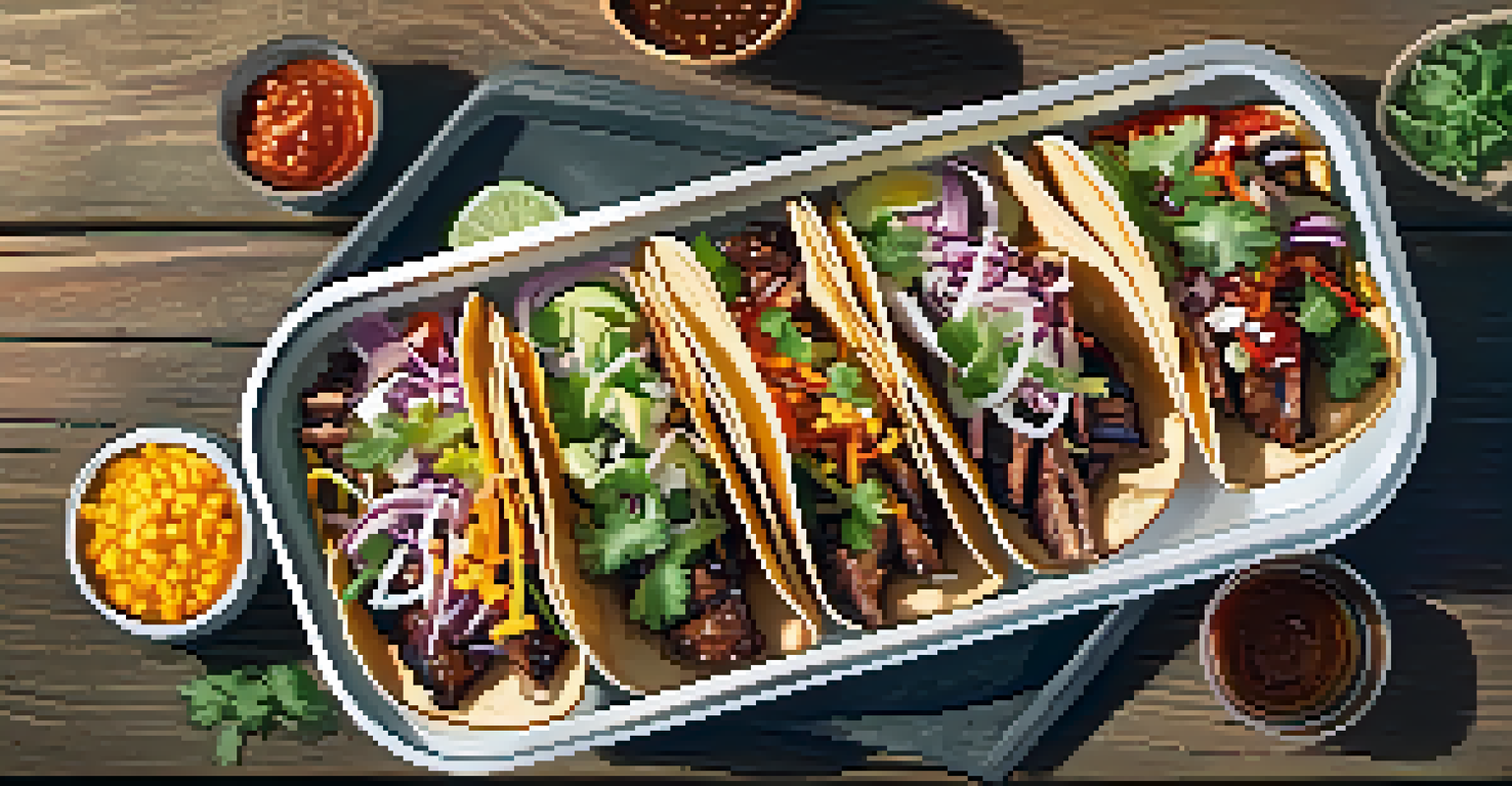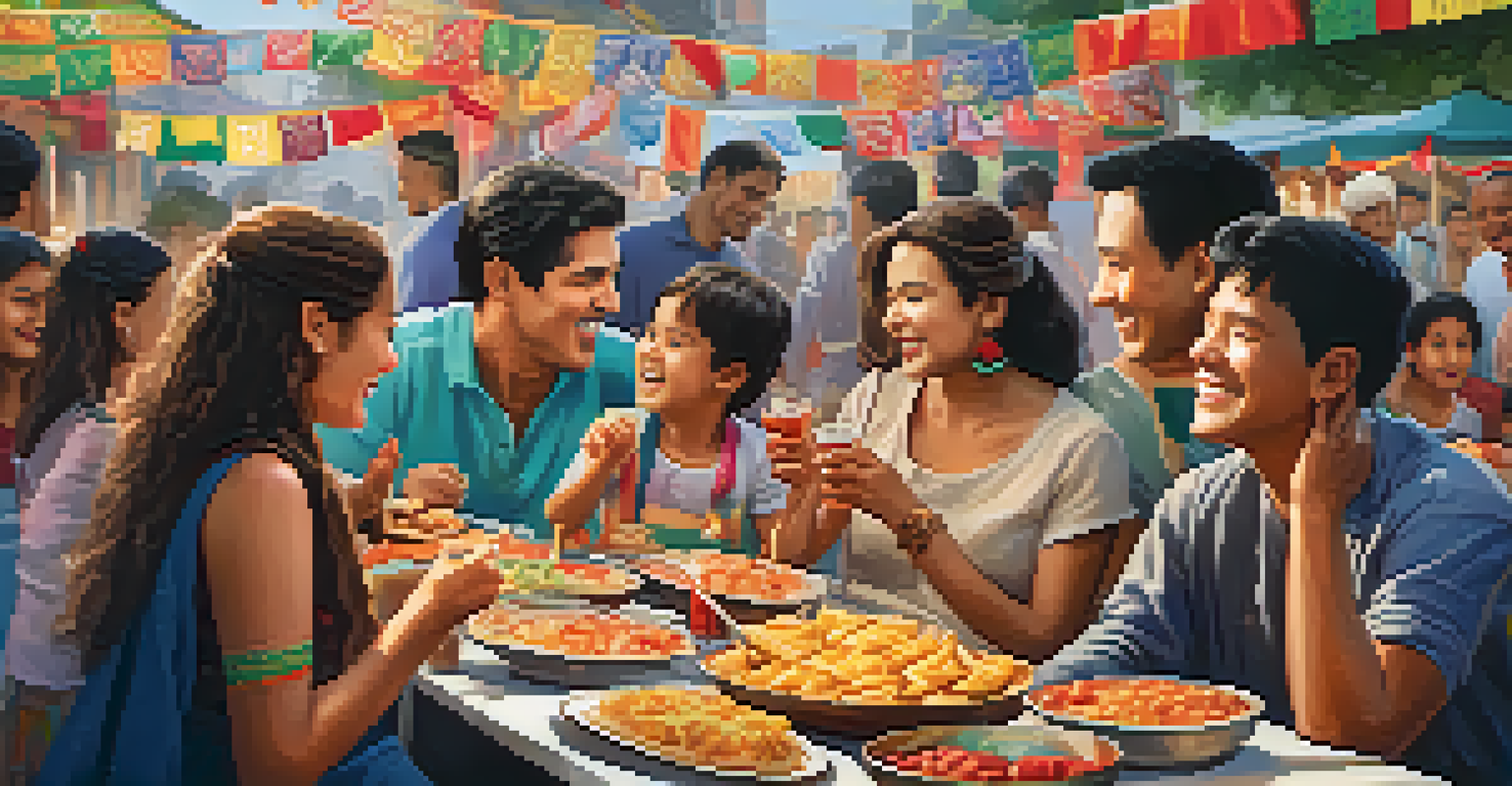Street Food: A Delicious Reflection of Cultural Diversity

The Global Appeal of Street Food: A Culinary Adventure
Street food isn't just a meal; it's a passport to a country's culture. From the bustling markets of Bangkok to the food stalls of Mexico City, street food invites you to experience local flavors and traditions. This culinary adventure often reflects the history and social dynamics of a region, making it a unique window into the lives of its people.
Food is our common ground, a universal experience.
Take, for example, the beloved taco in Mexico. It’s more than just a quick bite; it embodies the country's rich heritage, combining indigenous ingredients with Spanish influences. Similarly, the iconic banh mi in Vietnam showcases a fusion of French and Vietnamese flavors, illustrating how colonization can shape culinary landscapes.
Street food also evokes a sense of community, as vendors often serve generations of families. This connection between food and culture is why street food appeals to locals and tourists alike, making it an essential part of the global culinary scene.
Street Food Markets: The Heartbeat of Urban Life
In many cities, street food markets serve as vibrant hubs of activity and social interaction. These bustling spots bring together a diverse array of vendors and customers, creating a melting pot of cultures and cuisines. For many, visiting a street food market is a rite of passage when exploring a new city.

Imagine wandering through a night market in Taiwan, where the air is filled with the aroma of grilled squid and bubble tea. Here, you can savor delicacies from different regions while mingling with locals and fellow travelers. Such markets not only offer an array of flavors but also foster connections among people from various backgrounds.
Street Food: A Cultural Experience
Street food serves as a passport to local culture, showcasing the rich flavors and traditions of a region.
These markets often reflect the cultural diversity of a city, showcasing dishes that have been passed down through generations. They create a sense of belonging, where everyone can enjoy the universal language of food together.
Street Food: A Canvas for Culinary Creativity
Street food is not just about tradition; it's also a platform for innovation and creativity. Many street vendors are experimenting with flavors and techniques, blending traditional recipes with modern twists. This evolution keeps the street food scene dynamic and exciting.
Street food is about the people and the culture that surrounds it.
Consider the rise of gourmet food trucks in cities like Los Angeles, where chefs are reimagining classic dishes. From Korean BBQ tacos to fusion sushi burritos, these culinary mashups are pushing boundaries and inviting new audiences to enjoy street food. It's a testament to how food can evolve while still honoring its roots.
This creativity extends beyond just the food itself; it also includes the presentation. Street vendors often showcase their dishes in visually appealing ways, making them Instagram-worthy and attracting a younger audience. This blend of innovation and tradition makes street food a constantly evolving art form.
Health and Safety: Navigating Street Food Choices
While street food is a delicious adventure, it's important to consider health and safety. Not all vendors follow the same hygiene practices, so it's essential to be discerning when choosing where to eat. Look for busy stalls with high turnover; this often indicates fresh ingredients and good practices.
It's also wise to observe the vendor's setup. Cleanliness can vary widely, so pay attention to how food is handled and prepared. In many countries, local customs dictate certain practices that may differ from your own. Understanding these can help you make informed choices while enjoying the experience.
Health and Safety in Street Food
While delicious, street food requires discerning choices to ensure hygiene and safety when dining.
Street food can be a safe option when you prioritize vendors who adhere to hygiene standards. By doing your research and being cautious, you can indulge in delectable bites without compromising your health.
Cultural Festivals: Celebrating Street Food Traditions
Cultural festivals around the world often highlight the importance of street food in their local traditions. These events bring together food lovers and vendors, celebrating the rich tapestry of flavors that define a culture. They provide an opportunity to experience a variety of street food in one place, turning a simple meal into a communal celebration.
For instance, the annual Street Food Festival in Melbourne showcases a diverse range of cuisines, from Ethiopian injera to Japanese yakitori. These festivals not only promote local businesses but also educate attendees about the cultural significance of the dishes they’re enjoying. It's a wonderful way to foster appreciation for culinary diversity.
These gatherings also create a sense of nostalgia, as many people associate street food with family gatherings and shared experiences. By celebrating street food traditions, festivals help to preserve culinary heritage and promote cultural exchange.
Street Food: A Sustainable Option for Modern Eating
As the world becomes more conscious of sustainability, street food is emerging as an eco-friendly dining option. Many street vendors prioritize local, seasonal ingredients, reducing the carbon footprint associated with transporting food. This commitment to sustainability resonates with a growing number of consumers who are mindful of their environmental impact.
Moreover, street food often comes with less packaging than traditional dining. Many vendors serve food in reusable or biodegradable containers, further minimizing waste. This approach aligns with a global movement toward sustainable eating, making street food not just delicious but also responsible.
Sustainability in Street Food
Many street vendors embrace sustainability by using local ingredients and minimizing waste, appealing to environmentally conscious diners.
Choosing street food can be a way to support local economies while enjoying fresh and authentic cuisine. By opting for these sustainable options, you contribute to a healthier planet while indulging in delightful flavors.
Street Food: Bridging Cultures and Building Connections
Street food has a unique ability to bridge cultural divides and foster connections among people. When you try a dish from a different country, you’re not just tasting food; you’re experiencing a part of that culture. This shared experience creates a sense of unity, as food often serves as a conversation starter and a means to connect.
Think about the last time you shared a meal with someone from a different background. The stories, flavors, and traditions exchanged can lead to deeper understanding and appreciation. Street food has this power to bring people together, transforming a simple meal into a cultural exchange.

In a world that sometimes feels divided, street food stands as a reminder of our shared humanity. It shows us that despite our differences, we can come together over a plate of food, celebrating the diversity that makes our world so rich.